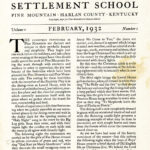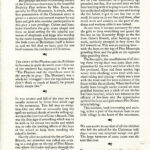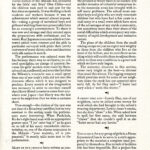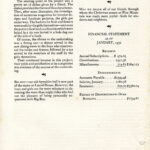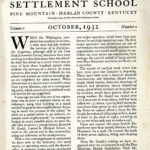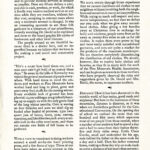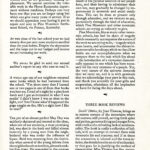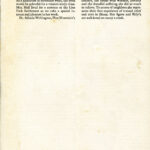Pine Mountain Settlement School
Series 17: PUBLICATIONS PMSS
NOTES 1932
February and October
NOTES – 1932
“Notes from the Pine Mountain Settlement School”
February and October
GALLERY: NOTES – 1932 February
At one time it became necessary for even the girls to drop everything and guard the fire-line on the Kentucky Ridge as the fire from Gabe’s Branch, after burning over a week, suddenly swooped in fury down the hill next to us.
- 001 NOTES 1932 February [notes_1932_02_001.jpg]
- 002 NOTES 1932 February [notes_1932_02_002.jpg]
- 003 NOTES 1932 February [notes_1932_02_003.jpg]
- 004 NOTES 1932 February [notes_1932_02_004.jpg]
TAGS: NOTES – 1932 FEBRUARY: Christmas festivities, Nativity Play, forest fires, schoolhouse stage, Mikado, Girls’ & Boys’ Glee Clubs, operetta, economic downturn, Sol Day, Lewdy Day, Home Economics Class projects, Ayrshire bull, livestock, financial statement
TRANSCRIPTION: NOTES – 1932 February
P. 1
NOTES FROM THE
PINE MOUNTAIN
SETTLEMENT SCHOOL
PINE MOUNTAIN * HARLAN COUNTY * KENTUCKY
Copyright, 1932, by Pine Mountain Settlement School
Volume v FEBRUARY, 1932 Number I
THE CHRISTMAS FESTIVITIES at Pine Mountain are distinct and unique in their symbolic beauty and simplicity. They begin just one week before the holidays, and take place every evening at the supper hour. One should really spend the week at Pine Mountain living the week through with students and workers in order to appreciate the joy and beauty of the festivities which have been planned for Pine Mountain and Pine Mountain only. The setting for these festivities with the exception of the Nativity Play is in the dining-room at Laurel House, with its interior of unfinished wood, low balcony, massive fire-place and the cheerful atmosphere which naturally associates itself with the place where we gather about the board for rest, comradeship and food.
A hush of expectancy is felt that first evening when we quietly assemble at our accustomed places in the dining-room and wait in the dusky dark for the opening strains of “Holy Night” sung in the court by the Big Log girls. Soon they enter, and with their tapers light the candles on each table and the room is all aglow with friendly light.
The following night the ceremonies are carried on by the girls of Far House dressed in sylvan costumes of green and red, who sing “God Rest ye Merry Gentlemen” while they decorate the small evergreen trees on the tables with wood pretties that have been gathered from the near-by forest. Later we hear in the distance the Farm House boys singing the old English carol – “From Far Away We Come to You;” the doors are opened, and, dressed in apparel which brings to mind zero weather, such as colorful stocking-caps, scarfs, overcoats and mittens, they bear the huge Christmas Tree which is set up in the corner by the glowing fire and is duly decorated with cheery lights.
By this time the Christmas spirit is truly in the air and the ceremonies of the following nights tend only to intensify what is now already here.
The third night brings the Laurel House girls to the fore, when, all dressed in white they sing “The Holly and the Ivy” as they drape the balcony surrounding the dining-hall with a long garland which they have woven. Following this the girls from the Infirmary and Practice House hang wreathes in every window as they sing “Ye Shepherds leave the Care of Flocks so Fleecy.”
The dining-hall is now completely dressed in green with an occasional touch of red and with the flickering candle-light presents a charming example of what may be done in decorative art with simple leaves and trees from the forests which cover the mountains round about us.
As yet we have had none of the hearty merriment of the season — but this arrives the following night when the boys of Boys’ House present a brief sketch of Old English life on Christmas Eve. We behold the Lord and Lady of the manor seated at the dining-table dressed in the costume of the eighteenth century, when in come a crowd of care-free boys dressed in the costume of that…
[1]
P. 2
…time, and bearing the Yule Log upon their shoulders. After this is placed upon the fire Santa Claus appears on the balcony and lowers to a representative of each house the gifts which go there. This is the climax and the sign for an appropriate measure of merry- making and fun among the students.
But perhaps the most outstanding feature of the Christmas observance is the beautiful Nativity Play written by Mrs. [Ethel de Long] Zande especially for Pine Mountain. A simple, effective presentation of the Christmas story is given in a sincere and earnest manner by our boys and girls who consider participation in this play a rare privilege. Cedars and hemlocks transform the gray stone chapel and form an ideal setting for the colorful costumes of shepherds and kings who worship by the rustic manger. Somehow it seems that the little town of Bethlehem itself is before us and we feel that we have seen for one brief moment the real heart of Christmas.
***
THE STORY of the Pharisee and the Publican is the same in spirit the world over –but one of our students has expressed it this way: “The Pharisee and the republican went to the temple to pray — The Pharisee’s was a whole lot ‘o braggin’ — but the republican he didn’t think so much of hisself, he prayed kindly simple like.”
***
IN THE SPRING and fall of the year we are usually menaced by forest fires which rage in the mountains. This fall was no exception. One day after an unusually long dry spell we noticed clouds of smoke rolling upwards in the direction of Gabe’s Branch. This was the first sign of something which was to be with us for almost two weeks and which was to take the untiring efforts of the boys of the school to keep from touching the school’s timber.
Shortly after we noticed the fire at Gabe’s Branch, our attention was called one evening to a red glow on the top of Pine Mountain where the Laden trail goes through the gap. This was the signal for action. The boys dropped everything, and with axes, fire- rakes, hoes and shovels proceeded to the boundaries nearest the approaching fire.
The school property is surrounded by several miles of fire-line which must be raked clean and patrolled so that no fire can jump across and damage timber which belongs to the school. The fire as yet had not come to our fire-line, but all the efforts on our part and that of several men could not stop the fire on Pine Mountain as it gradually approached our line. For several days we had been battling with it hoping to save the timber on the land adjoining our own and to stop the fire before it got to our line but to no avail. It came on to our line and there, after much work and anxiety on the part of students and workers alike it was halted.
At one time it became necessary for even the girls to drop everything and guard the fire-line on the Kentucky Ridge as the fire from Gabe’s Branch, after burning over a week, suddenly swooped in fury down the hill towards us. This was an exciting time — with the boys on the top of Pine Mountain guarding there and the girls on the opposite ridge guarding there.
The fine spirit, the unselfishness of all during these trying days was more than compensation for the worry and labor which the fire produced. Eyes red from smoke; legs weary with climbing; arms tired with constant raking and cutting — which was a race with the wind and fire were evidence of the finest within the students. When the fire had finally been brought under control we were gratified because not a stick of our timber had been touched, which was witness to the efficacy of fire-lines and the appreciative spirit of the boys and girls whom Pine Mountain is helping.
This incident, both interesting and exciting, is but a part of the routine here in our little village in the heart of the mountains.
***
WE ARE HAPPY to say that of all the children who left the school for the Christmas holidays every one returned except one girl. The large turnover of some years was absent this year.
***
THE LAST SATURDAY NIGHT in November saw the stage in the school-house transformed into a setting which might be located any-where in Japan. A bit of scenery artfully…
[2]
P. 3
…drawn in crayon on several old sheets by one of the workers provided the background; hand-made cherry-blossoms; Japanese lanterns; rustic furniture took us into the Courtyard of Ko-ko that simple minded scalawag who features in Gilbert and Sullivan’s Mikado.
After rehearsing for four weeks an abbreviated edition of the Mikado was produced by the Girls’ and Boys’ Glee Clubs — and the children took part in and saw for the first time an operetta. It was thrilling to both students and workers because it was an achievement which seemed almost impossible — taking a group of untrained boys and girls and wielding them into presentable form for an evening’s entertainment. To them it was new and strange and they entered upon the preparations with enthusiasm and interest. Real Japanese costumes which we borrowed added more interest and the girls in particular surveyed with pride their pretty costumes of many dainty color combinations with silk sashes to match.
The performance was enjoyed none the less because there was no orchestra; no colored spot-lights; no change of scenery; because the girls’ sandals were made by themselves from cardboard; and even the fact that the Mikado’s mustache was a small spray from one of our mule’s tails did not mar the dramatic effects which it was designed to produce. Every stretch of the imagination was necessary in order to convince oneself that Harry Brook’s costume came from anywhere near Japan — but Harry was the last one to be suspicious that we were a costume short.
True enough — the diction of the cast was not that of a Broadway satellite; but its very contrast to the setting made the performance more interesting. When Pooh-bah, Ko-ko’s right hand man with an appropriate gesture says “I jes’ caint hep it” as he goes on to tell of his many remarkable characteristics; or, one of the chorus announces to the Mikado-“your majesty, all is prepaaared;” it merely adds more zest to the performance.
***
MANY OF OUR FRIENDS have written us concerning the effect that the industrial situation in Harlan County is having upon the work at Pine Mountain. The large number of applications for admittance to the school we believe is in some respect due to the difficulties resulting from the unstable conditions in the county. We receive numerous applications from boys and girls who live on the other side of Pine Mountain.
The territory itself is sick from the effects of an industry which is unregulated and for the product of which there is no market. The sudden invasion of industrial enterprises into the mountain areas has brought with itself many problems. The school must consider boys and girls who are truly mountain children but who have had a few years in a coal camp or a small town which have none of the advantages of any stable community, but sometimes more than their share of the social difficulties which accompany any community of rapid development and tentative nature.
The pleas of the children from the small mining camps are just as urgent and weighty as those from the children who live at the head of the hollow; and to contribute something which will enable them to adjust themselves to these new conditions is a great task which we have only begun.
The economic situation in this section, never very bright at the best — is dimmer than usual this winter. The logging company which provides work for some of our neighbors down the creek has not operated since early fall. As Sol Day said “I haint had nary a lick o’ work this winter.”
***
A SHORT TIME AGO — Lewdy Day, one of our neighbors, came to collect some money for wool which she had brought to the school’s weaving department. Lewdy doesn’t smoke, but she does “chaw” a bit. When asked how to spell her first name, she said between “chaws” that she couldn’t spell it as she “haint never had any larnin.”
***
THE CLIMAX for any group of girls in a Home Economics Class is to serve in a style appropriate to the occasion a complete meal prepared by themselves. Due to lack of facilities this has been impossible. But a project has been completed whereby they can usher you now into a charming dining-room, quickly and easily assembled in the corner of the sewing-room.
[3]
P. 4
The walls of the room are portable screens of brown burlap decorated with green and orange. The frames for the screens were made by the boys in the woodworking department as well as the beautiful oak table of early American design with a serving table to match.
The starting point of the project was a pretty set of dishes given by a friend. The dishes provided the theme of the colorscheme. Then, after some discussion; the investigation of numerous magazines for interior designs and furniture patterns, the girls got under way. The baskets for fruit and flowers were made by the girls themselves and even the pottery bowl and candlesticks which were baked in a tin can buried in a hole dug out of the side of a bank.
Of course, the climax to the undertaking was a fitting one — a dinner served in the new dining-room to the boys who constructed the tables and frames; followed by a tea served to the members of the staff by the girls themselves.
Their continued interest in this project; their pride and satisfaction at its completion was evidence of the success of the undertaking.
***
BIG BOY — Our old [Ayrshire] bull is now part of the menu at Laurel House. However, the boys and girls are far more reluctant to devouring the meat than might folks who had not the pleasure of being personally acquainted with Big Boy.
TO OUR LIVESTOCK we have added six new pigs, two fully grown and four chotes. For their place of residence we have constructed an approved hog house with concrete floor; windows in the roof and doors which can be raised — thus providing a maximum of fresh air and sunlight.
***
MAY WE THANK all of our friends through whom the Christmas season at Pine Mountain was made more joyful — both for students and neighbors.
***
FINANCIAL STATEMENT
as of
JANUARY, 1932
Receipts
Annual Subscriptions….$ 979.05
Contributions……………… 2351.36
Miscellaneous…………….. 314.82 $3645.23
DISBURSEMENTS
Accounts Payable…...$2399.48
Salaries, January……… 2180.56
Insurance………………… 800.00 $5380.04
EXCESS OF DISBURSEMENTS OVER
RECEIPTS………………$1734.81
[4]
The Marchbanks Press, New York
GALLERY: NOTES – 1932 October
We point with pride to the five minor operations and the one major operation which have been performed [by Dr. Kenneth N. Gould] in our little operating room.
With a view to vocational training we have secured a small six-by-ten hand printing press, and a few fonts of type.
- 001 NOTES 1932 October [notes_1932_10_001.jpg]
- 002 NOTES 1932 October [notes_1932_10_002.jpg]
- 003 NOTES 1932 October [notes_1932_10_003.jpg]
- 004 NOTES 1932 October [notes_1932_10_004.jpg]
TAGS: NOTES – 1932 OCTOBER: need for new local doctor, infirmary, Kenneth N. Gould, medical work, dental clinic, Pine Mountain Health Association, Henry Creech, gardening, vocational training, printing press, printing shop, donating clothes, Mrs. [Lexine]. Baird, Home Economics Class, sewing machines, depression, May Day, murder, vengeance, book reviews, Dr. Alfreda Withington
TRANSCRIPTION: NOTES – 1932 October
P. 1
NOTES FROM THE
PINE MOUNTAIN
SETTLEMENT SCHOOL
PINE MOUNTAIN * HARLAN COUNTY * KENTUCKY
Copyright, 1932, by Pine Mountain Settlement School
Volume v OCTOBER, 1932 Number 2
WHEN Dr. [Alfreda] Withington completed her excellent work here, a wide area was left without the services of a physician. Dr. [Ida] Stapleton, although still at the Line Fork Extension Center, was more than busy working in a direction away from the school. So with the school as a center there was an area of land three hundred square miles without the services of a doctor. In many instances this made it very difficult for the school and worked an extreme hardship upon our neighbors for miles around. When the services of a doctor were needed he came from a great distance, and at a corresponding price, which practically prohibited medical service for our neighbors.
A year ago we said that one of our aspirations was to have a resident doctor at our infirmary, using that building as a much needed hospital in this neighborhood. Keeping in mind the purpose of the school “to serve as a social center in an isolated, intensely rural neighborhood,” by cutting our budget in every possible place we were finally able to secure a young doctor, Kenneth N. Gould, Louisville Medical School, to work in the school and in the community, using our infirmary as his headquarters.
With a few rearrangements in equipment we have now at the infirmary two small wards, an operating room, and the doctor’s office. A pressure cooker serves excellently as a sterilizer, and some hay bale wire serves as the form for an ether mask. We point with pride to the five minor operations and the…
…one major operation which have been performed in our little operating room. The first major operation was performed on one of our workers who was suddenly stricken with appendicitis, and would much rather be operated on, even under our conditions, than undergo the painful ordeal of being carried over Pine Mountain and down to Harlan on a stretcher.
The record of medical work which has been done since last January is imposing. There have been over a hundred physical examinations and histories, fifteen microscopic blood counts, sixty-one dressings of wounds and abrasions, eleven obstetrical cases, one of which without our hospital and its facilities would have proven fatal to a young mother. Dr. Gould has visited over 175 homes one or more times, and has been called out 135 times. 1500 typhoid [inoculations] have been given to over 500 individuals. Since we cannot afford a horse for Dr. Gould, he makes all of his trips on foot, many of them in the dead of night, traveling as far as ten miles each way to make a call.
Upon our request the state Health Department sent their dental clinician to Pine Mountain for a week. He treated the teeth of forty-seven children, filling and cleaning them.
Since Dr. Gould’s coming we have organized what we are pleased to call the Pine Mountain Health Association. With Mr. Henry Creech we rode for a whole day summoning our neighbors to a meeting to organize this new association. When the day…
[I]
P. 2
…for the meeting arrived forty-three families were represented and we were amazed and pleased at this show of social consciousness among our isolated neighbors. President and Secretary were elected and rules and regulations were drawn up. The purpose of the Association is to promote healthful living and to provide medical services as cheaply as possible. Dues are fifteen dollars a year, payable in cash, produce, or work, for which a family may receive medical service at any time while they are members, without further cost, excepting in extreme cases where only a minimum amount is charged. It was an interesting spectacle to see these folk gathered in a classroom of our schoolhouse, intently watching Dr. Gould as he explained and drew on the board graphic life cycles of hookworm and other local diseases.
The people around us are thankful because there is a doctor here, and we are gratified because we believe that we have in the making a real social and community project.
***
“HIT’S A SIGHT how hard times are, and a man sure cain’t git hold of no money these days.” So away in the hills of Kentucky was voiced the general sentiment of people everywhere. With hard times in mind the students and workers at Pine Mountain have worked hard and long to plant, grow and store away food stuffs for the coming winter. Every available inch of ground has been planted. 12,000 cabbages are gradually heading up to supply us with the only green food of the long winter months. Corn is waving on four hillsides and soon we shall dig up bushel after bushel of potatoes. 2300 two-quart jars of beans, beets, peas, carrots, tomatoes, and blackberries pack every available inch in the cellar store room, and there yet remain two fields of fall beans to be gathered.
WITH A VIEW to vocational training we have secured a small six-by-ten hand printing press, and a few fonts of type. Three of our boys have taken an active interest in this work, and one of them, who is keenly interested in the new project spends most of his free time in the printing shop. We are glad to say that despite the decline of all other sorts of business we have a growing demand for printed stationery. We now print our own student application blanks, treasurer’s notices, health reports, and a little four page school paper [Pine Cone?].
***
WE HAVE FOUND through bitter experience that we cannot distribute old clothes to our neighbors without involving both the neighbors and ourselves in many serious problems. While trying to teach self-respect and economic independence, we find that we defeat our own ends when we give away second-hand clothes. After giving a few bundles away at Christmas time in exchange for holly and mistletoe, people came from as far away as twenty-five miles to ask us for old clothes. It makes them more prone to beg and more easily satisfied with second-hand garments, and cuts out quite a market for the products of the mountain storekeeper. We are therefore completely discontinuing the distribution of old clothes. We should, however, like to receive baby clothes and layettes, as they fit in nicely with the work of the Pine Mountain Health Association, and can be given as rewards to those mothers who have properly observed the rules and suggestions given by Dr. Gould and Mrs. [Lexine] Baird, the nurse, to expectant mothers.
***
DISTANCE! How it has been shattered in the outside world of fast trains, good roads and airplanes! But here in the fastnesses of these mountains, distance is distance, as it was when our forefathers gathered for the Constitutional Convention. On the opening day of school we realized the more than one hundred and fifty years which separates most of our people from those outside, when a number of our students had to spend a day and a half to come from their homes thirty-five and forty miles away. Little Cleon Combs, small and undersized for his age, rode behind his father on the same mule for a day and a half. Then his father returned home, making a three day trip on mule-back to cover a distance of not more than seventy- five miles!
The mountain people know nothing of the commuter who travels this distance as a…
[2]
P. 3
…part of his everyday work. What a distance in time between the lives of you who read these NOTES and those for whom they are written!
***
SOME OF the sewing machines which our friends sent us are gradually needing replacement. We cannot continue the valuable work in the Home Economics department without machines. Perhaps you may have one that you are no longer using but which can give many years of service. If so we should appreciate your having it put in repair and sent to Pine Mountain Settlement School, via Putney, Kentucky.
***
AT THE close of the last school year we had twenty-five per cent more students enrolled than the year before. Despite the depression and the large cut in our budget and income we are increasing our work.
***
WE SHALL be glad to send our annual auditor’s report to any who care to read it.
***
A WHILE ago one of our neighbors returned some books which he had borrowed from the school. “I’m shore sorry that I burned one or two pages in one of them thar books you lent me. I read of a night by a pine knot torch and I got so interested in what I was readin’ I didn’t know I was so clost to the light, and ‘fore I knew what’d happened the page caught on fire. Hit’s a sight how I like to read!”
***
THE JOY of an almost perfect May Day was suddenly shattered and marred at the close, when one of our students, a most promising lad, was shot in the back and killed almost instantly by a young man from the neighborhood who was under the influence of liquor. Reid was returning from the festivities when several of the young fellows from the neighborhood ran into him, almost knocking him down. He responded in the manner characteristic of mountain boys and knocked them down. They followed him for some distance and shot him.
The deep shock and sorrow which we all felt sharpened our realization of the need for turning the undisciplined individualism of our young people into channels of personal and social well being. The deeply ingrained idea of seeking personal redress for any injury no matter how trivial, which is a result of the peculiar isolation of our people here, and their having to administer their own law, may gradually be changed by improvement in economic and social conditions. This can be done at present only through education, and we venture to say, particularly through the kind of education, which Pine Mountain and other mountain schools are trying so valiantly to give.
Pine Mountain, like so many other mountain schools, has had its share of tragedy which necessarily accompanies the nature of the work we are trying to do, — tragedy which tears hearts, and accentuates the almost insurmountable handicaps which we face. How feeble are our accomplishments when we compare them to the task which lies ahead — the introduction of a viewpoint diametrically opposed to one which has been necessary for the very existence of a people. Yet, the very nature of the universe demands that we carry on, and it is with gratitude that we acknowledge your part in this task, and thank you sincerely for your gifts and cooperation, oftentimes all the inspiration we have for facing the days ahead.
***
THREE BOOK REVIEWS
Devils’ Ditties, by Jean Thomas, brings us to remote corners of the mountains where old customs still prevail, serving forth spice and pathos, generous living and meager lives, with truth and a refreshing lack of sentimentality. The book is really a collection of ballads, with an attempt to connect them with mountain life and customs; and if at times the connection is labored and the tunes inferior, the details breathe an air of authenticity that goes far in justifying the method of presentation. Miss Thomas has fine material at her command and the book is extremely readable, being entertaining and moving by turns.
[3]
P. 4
In The Here-to-Yonder-Girl by Esther G. Hall (McMillan) we have a mountain story for young people in which plot and setting are properly related. With the exception of an idiom or two misused, the study of the language, conditions and customs is excellent, and the characters well undertaken. As a handbook of mountain ways, the book would be splendid for a mission study class. Mrs. Hall lived for a summer at the Line Fork Settlement so we take a special interest and pleasure in her work.
Dr. Alfreda Withington, Pine Mountain’s doctor from 1923 to 1930, is publishing her letters in the September and October Atlantic under the title “The Mountain Doctor.” Pine Mountain’s friends will follow her trips in the saddle to the most inaccessible spots with special interest, appreciating her vivid descriptions, her love of the people and the country, her battle with weather, poverty and the dreadful suffering she did so much to relieve. To scores of neighbors she represents their first experience of trained relief and cure in illness. Her figure and Billy’s are well-loved on many a creek.
[4]
The Marchbanks Press, New York
Previous:
NOTES – 1931
Next:
NOTES – 1933
See Also:
DRAMA Guide
EVENTS MAY DAY Guide
FARM Guide
MEDICAL Guide
Return To:
NOTES Index

